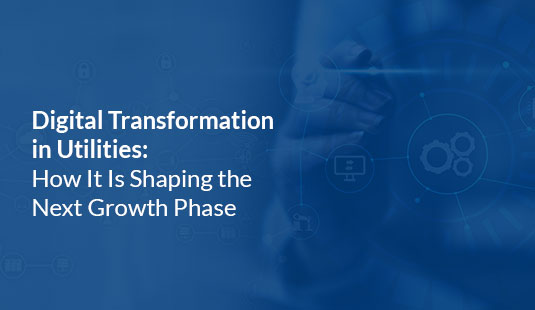Digital Transformation Trends in Utilities: How It Is Shaping the Next Growth Phase
The utility industry is undergoing massive, unprecedented disruption across the value chain. This shift is driven primarily by the widescale adoption of digital technologies, evolving customer expectations, heightened competition, and dynamic market conditions. As more and more customers now expect a digital relationship with their utility providers, they are quick to change loyalties if this request is left unmet.
There is no doubt that businesses that are quick to adapt to growing customer expectations, build an ecosystem, and switch to digital operations will create new revenue streams, improve customer engagement, and increase revenue and profitability. That said, all this must be achieved against the backdrop of growing demand for advanced tech, smart cities, and electric mobility while staying focused on renewable energy sources and sustainability.
A recent Oracle-IDC survey suggests that revenue growth is the #1 priority for digital transformation in the utility industry across regions. But to achieve that, utilities must adapt to the needs and wants of the digitally savvy and sustainability-focused new-age customer. This is of particular significance since the report also suggests that by 2031, gen-z and millennials will make up 60% of the global consumer population. And to serve this new breed of customers, utilities must “transform into multi-product and multi-service organizations and energy suppliers” by:
- Embedding customer engagement into the CX platform
- Unifying customer service and sales
- Embracing flexibility
Digital Transformation Trends to Watch Out For
The pandemic accelerated the adoption of digital technologies across industries. And while traditionally slow to embrace change, digital transformation in utilities has become a business imperative. From the implementation of cloud and big data analytics to IoT and automation, digital tech is shaping the future of the utility sector and opening up new revenue streams.
Cloud and AI are accelerating growth
Industry research has found that almost all utility leaders have implemented comprehensive cloud solutions, with 84% embracing cloud SaaS to make operations more nimble and scalable, drive remote and hybrid models, and increase productivity. Additionally, as data explodes, applying new-age technologies such as AI, machine learning, and robotics leads to higher performance across technologies and more effective data insights that drive better decisions. From automating business processes such as accounting to using chatbots for enhanced customer interactions to effectively operating self-governing machinery and vehicles, AI and robotics underpin enterprise efforts to deliver customer delight and grow business.
With 84% embracing cloud SaaS to make operations more nimble and scalable, drive remote and hybrid models, and increase productivity

Modernization and automation are gaining momentum
Grid modernization has been a critical focus for utilities in recent years. According to the National Council of State Legislatures, the US alone will spend up to $2 trillion on grid modernization by 2030 to maintain the electric grid’s reliability. The focus of this modernization effort is not limited to enhancing operations but also addressing climate change challenges, reducing GHG emissions, and offering all customers—industrial, commercial, or residential—the same degree of control and transparency as other industries. Utilities are undertaking grid modernization efforts to improve reliability, reduce costs, and deliver an enhanced customer experience with better insights and control of their consumption.
Cybersecurity will continue to be a top priority
A higher degree of digital transformation in utilities also exposes the industry to a broader range of cyber threats. No utility today can afford to expose its infrastructure and data to cyberattacks that could have a catastrophic impact on operations and even national security by causing widespread blackouts, disrupting gas supplies, or compromising water supplies. Modern utilities need to secure customer data and business operations through robust technology enhancements, improved security architecture, and updated business processes. And given the increasing government regulations and unprecedented customer concerns around privacy, cybersecurity has become an indispensable part of utility operations today.
Delivering an exceptional customer experience is critical
A McKinsey survey found that high-performing utilities had 3x to 4x higher net customer satisfaction than the laggards. High performers prioritized customer journeys and focused on satisfaction parameters, such as easy access to information, timeliness, and clarity. Yet another Oracle-IDC report suggests that for utilities to grow, they must digitally transform revenue and customer operations. And in a bid to enhance customer experience and CSAT scores, utilities are focusing on mastering the multi-service model, customer engagement, and operational efficiency. In addition, about 50% of utilities are “investing in an integrated platform supporting CX and back-office processes,” while 60% of energy utilities are investing top dollar in pre-configured industry-specific CX management solutions.
The Digital Utility: New Opportunities and Challenges
The utility trends discussed above are substantially influenced by evolving market dynamics, such as competition and a renewed focus on sustainability.

Hyper-competition and churn
In Europe, an average of 15% of utility customers change their provider every year. To minimize customer churn and run a tight ship, utilities must focus on a strategic roadmap and robust platform that ensures customer engagement and loyalty and optimizes processes and service delivery.

Operational challenges of balancing supply and demand
Energy and utility providers are challenged to balance supply and demand with the global mandate to lower carbon emissions and shift toward renewable energy sources. By leveraging data insights, utilities can make more informed decisions and appropriate tech interventions to ensure continuous and efficient supply.

Problems related to data gathering
Collecting data at a utility is not always easy. From data quality to data collection and storage modes, all pose a significant challenge to its effective utilization.

Climate change and environmental responsibility
Climate change is a double-edged sword for the utility sector. With an increased focus on sustainability, the industry is looking for new ways to reduce its carbon footprint while also bearing the brunt of extreme weather events. An S&P report finds that utilities’ physical operations are highly vulnerable to climate events like storms and wildfires. Utilities that tap technology and move fast to address climate threats will ensure a competitive edge and be better positioned to mitigate climate challenges.
Digital Transformation for Utilities: A Strategic Approach
- Digital transformation is no longer just a nice-to-have but a business imperative. It is emerging to innovate and explore new revenue streams, build tighter bonds with the customer, drive better operations, and ensure regulatory compliance and security.
- CriticalRiver is at the center of how utilities can speed up their digital transformation and ensure business productivity and profitability. With expertise in Oracle utility solutions, we help global businesses address the challenge of growing complexity in a fast-transforming industry.
To understand how CriticalRiver can help you thrive in a sustainable, affordable, and more productive future, write to us at contact@criticalriver.com.




